Piano Blog by Skoove – Piano Practice Tips
Today we’re going to explore seventh chords, how they are constructed, how they sound, along with song suggestions that include different types of seventh chords and how you can incorporate them into your arrangements. As a pianist, being introduced to seventh chords years ago was an eye-opener for me and fueled an exciting progression in my playing. I hope this article paired with the help of the supportive material within Skoove does the same for you.
Table of contents
Click here for an overview of the topics covered in this guide
History of Seventh chords
The use of seventh chords dates back to the Baroque and Renaissance periods when composers like Monteverdi would use them in his cadences. At a time, the use of some Seventh chords was considered unorthodox as they didn’t fit with some traditional models of composing. Thankfully, that hasn’t been the case for some time, and today you will struggle to find a radio station playing music that does not feature seventh chords.
Before we dive into the world of learning all about Seventh chords, it’s important you have a good grasp of two things; these being basic chord triads and intervals.

Types of triad
There are four different types of triad. These are major, minor, diminished and augmented. You can see an example of the different chord types below and you can read more about constructing these types of triads here.

In the above example, the C Major Triad uses notes C, E and G. The C Minor triad uses notes C, E flat and G. The C Diminished Triad uses C, E flat and G flat. The Augmented Triad uses C, E and G sharp.
Exercise: Try playing these triads on your piano or keyboard and notice the different sounds they produce and moods they evoke. This trains your ear and also allows your fingers to become familiar with the chord positions.

Related:
- Major and minor chords
- Easy piano chords for beginners
Intervals
In terms of sevenths, we have either a Minor Seventh, a Major Seventh or a Diminished Seventh. The major seventh interval is 11 semitones (or half steps) above the root note, the minor seventh interval is 10 semitones (or half steps) above the root note, and the diminished seventh is 9 semitones (or half steps) above the root. For example, in the key of C major, the minor seventh interval would take you to B flat, the major seventh interval would take you to B, and the diminished seventh would take you to B double flat, also known as A (keep calm, more about this later).
Related:
- Understanding piano intervals
What is Skoove?
Throughout this article you will see me recommend material in Skoove and here is why. Skoove is an excellent online interactive learning platform for piano students. It breaks complex ideas and songs down into easy to understand chunks and allows you, the student, to learn at your own pace whilst giving you real time feedback on your playing. If you haven’t already, sign up for a 7-day free trial and see what you think.

Constructing seventh chords
Seventh chords are built by using one of the four triads above and adding a seventh above root of that triad. The Seventh adds a level of depth, emotion and complexity to the triad which can then make it appropriate to be used in music such as Jazz, R & B, Blues, Film Music and many Pop songs. Music genres tending not to use Seventh chords so much would be the likes of Rock, Heavy Metal, EDM, early medieval and Punk.
Types of seventh chords
Major seventh chord
The first chord we are going to look at is the Major Seventh chord. This is a common chord which you will have heard in many types of contemporary music and even so far back as the romantic era with examples in Claude Debussy’s Au Claire De Lune. Major Seventh chords are often found in romantic ballads and soul music; they possess a warm feel to them so you find them used a lot in love songs.
The Major Seventh chord is created by adding a Major Seventh to the root of a Major Triad. In the key of C major, in root position, the chord would consist of C, E, G, B. For this chord, you will often see it written on sheet music and lead sheets as Cmaj7 or C ∆
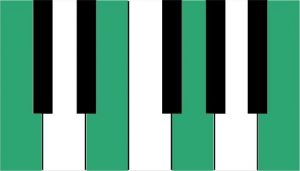
Much like learning a new word, the best way of learning about seventh chords is to understand the theory behind them and then see and hear them in context. Take a look at this tutorial of Coldplay’s A Sky Full Of Stars in Skoove to experience the major seventh chord in action.
Minor seventh chord
Minor Seventh chords are another heavily featured chord in Pop and R & B Music. It is a very versatile chord, used in succession it can create a sombre feel to a song whereas used once in a mostly major chord progression it can add contrast and depth. To create a Minor 7th chord, you add a Minor Seventh to the root of a Minor Triad. In the key of C minor, in root position, the chord would consist of C, E flat, G and B flat. For this chord, you will often see it written on sheet music and lead sheets as Cm7, Cmin7 or C –

Before we move on to dominant seventh chords, a great way of consolidating what we have gone through so far is to take a look at the ‘Candlelight chords and seventh chord formula’ lesson below. Here, Skoove patiently walks you through a progression that features both the major seventh chord and minor seventh chord.
Dominant seventh chord
Dominant Seventh chords are a staple of Blues and Jazz music but also feature in other genres such as Latin, Bluegrass and Pop. They have a unique energy about them combined with a tension created by the tritone within them. To create a Dominant Seventh chord, you add a Minor Seventh to the root of a Major Triad. In the key of C, in root position, the chord would consist of C, E, G and B flat. For this chord, you will often see it written on sheet music and lead sheets as C7, occasionally Cdom7.
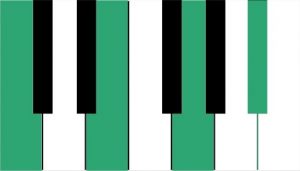
Dominant seventh chords are used extensively in Blues music, particularly Boogie Woogie. For a great introduction to dominant sevenths in blues, take a look below at the ‘Bouncie Boogie’ lesson in Skoove to learn how to play dominant seventh chords in the context of a 12-bar blues progression with some nice dominant seventh chords in the right hand. Skoove breaks the progression down so you can learn at your own pace and get to experience what a dominant seventh chord feels like and sounds like over a groovy bass line.
Minor/major seventh chords
The minor/major seventh chord has a very interesting feel to it. You’ll hear this type of seventh chord often used in film soundtracks and jazz music and from time to time it makes a cameo appearance in some pop music. To create a minor/major seventh chord, you add a major seventh to the root of a minor triad. In the key of C, in root position, the chord would consist of C, E flat, G and B. For this chord, you will often see it written on sheet music and lead sheets as Cminmaj7 or C – maj7.
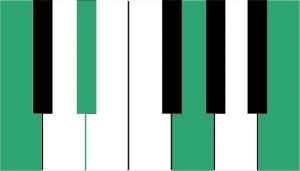
Try playing this chord on your piano or keyboard and see which film music it reminds you of…

Half diminished seventh chord
The half diminished seventh chord has been used in music for centuries and can be found as far back as compositions by Bach, Chopin and Mendelsohn. The chord sounds quite melancholic which also lends it well to being used in Jazz and Musical Theater. To create a half diminished seventh chord, you add a minor seventh above the root of a diminished triad. In the key of C, in root position, the chord would consist of C, E flat, G flat, and B flat. For this chord, you will often see it written on sheet music and lead sheets as CØ7 or Cmin7(b5).
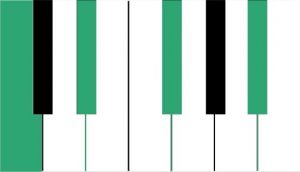
An excellent example of this chord is featured in the Latin jazz song ‘Sway’, see the tutorial below to learn how to play the half diminished seventh chord as part of a well-known mambo jazz classic.
Diminished seventh chord
Diminished seventh chords don’t feature so much in contemporary music however you will find them a lot in music from the Classical and Romantic eras and in various film scores as they are fantastic at creating a sense of trepidation, tension and doom. To create a diminished seventh chord, you add a diminished seventh above the root of a diminished triad. In the key of C, in root position, the chord would consist of C, E flat, G flat, and A (yes, A). The reason this chord features an A is because the seventh gets flattened twice due to a diminished seventh chord comprising a structure of minor thirds. For this chord, you will often see it written on sheet music and lead sheets CΟ7 or Cdim7.
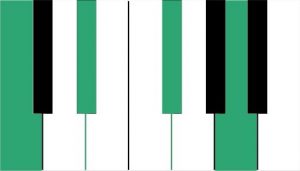
For a great example of this chord being featured beautifully, check out the Skoove tutorial Au Claire De Lune below and pay attention to the notes in bar 3. Skoove allows you to study the score here whilst listening to the sound of the diminished seventh which will help you to learn both how these chords are notated and how they sound.
Augmented seventh chord
Augmented seventh chords are a most commonly featured in jazz music particularly as substitute chords for dominant sevenths. To create an augmented seventh chord, you add a minor seventh above the root of an augmented triad. In the key of C, in root position, the chord would consist of C, E, G sharp, and B flat. The reason this chord features an A is because the seventh gets flattened twice due to a diminished seventh chord comprising a structure of minor thirds. For this chord, you will often see it written on sheet music and lead sheets Caug7 or C7(#5).
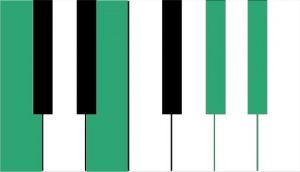
Try including an augmented seventh chord as a substitute for a dominant seventh using the chords in the Georgia On My Mind tutorial as a guide.
Seventh Chord Inversions
Now it’s time to discover what seventh chords sound like in different inversions. Inversions open up a world of possibilities for voicing your seventh chords. For basic triads, you have two inversions, however for seventh chords, you have three. For my younger years, I was mostly classically trained going through the graded system. Although this system had its merit, I felt a little stifled by that way of learning, so when I was around 18 years old, I found an excellent Jazz Pianist who agreed to teach me. In the first few lessons he introduced me to seventh chords and the inversions of them and it was an absolute game changer in terms of my playing and my understanding of chords and progressions. I was sat at the piano more that year than any previous year exploring what he had shown me.

Playing seventh chords in context
Seventh chords typically exist in songs with other seventh chords. A great example of this is in the jazz standard Autumn Leaves. In this song, you have dominant seventh chords, minor seventh chords, major seventh chords and half diminished seventh chords. The lesson below gives you the seventh chords above the notation, try playing the right-hand melody in the video and use seventh chords in your left hand to accompany. You will need to think the seventh chords out beforehand, and perhaps even write them down, but with practice, these chords will become second nature.
Practicing seventh chords
One of the most fun parts I find about playing the piano is getting to make my own arrangements of songs. Just because the song didn’t use seventh chords in the commercial recording, doesn’t mean you can’t use them in your arrangement of the song. Use your ear and if you think using a seventh chord sounds better in a certain place in the song, put it in there. Make it your own and express your own taste.
Summary
Learning piano is a lifelong journey, and sometimes we progress rapidly and at other times it can feel hard earned, however there are times when there are “Ah ha” moments of realisation and discovery where we come across something that leapfrogs us to the next level in our understanding of music and for me, learning about seventh chords and practicing them was one of those moments. I hope this article, the seventh chords featured in it and the tutorials in Skoove resonate with you!
Read More
This article is from an external source and may contain external links not controlled by Empeda Music.

